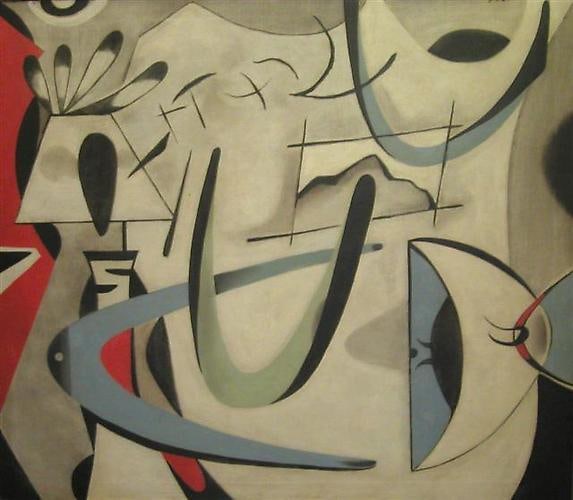Developed in Europe, the movement known as Surrealism included artists who painted the fleeting images and moments of their subconscious activity and dreams.
By the time the Museum of Modern Art held their landmark 1936 exhibition on Surrealism, Walter Quirt was already defining his approach to Surrealism that had been displayed first as early as 1933. Quirt’s attitude was that Salvador Dali and others had not taken full advantage of the possibilities that Surrealism offered, and that artists using free association to explore the language of emotions on problems the public feels but has not the means for projecting into actualities was a positive move. (2)
Quirt’s painting reflects a subliminal consciousness that is based in Hegelian theories of metaphysics and psychoanalysis, and James Joyce literature. (3) Quirt’s dreams supplied this disturbing theatrical imagery of interlacing color and distorted clown figures. Given Quirt’s previous tendency toward social commentary and the current events of World War II, his paintings could be interpreted as a discourse on the problems of the era, but more likely was one such as those described in the early 1940s as enigmatic.
Quirt's style shifted late in his New York career when he abandoned the social realist politics and imagery that had dominated his early years as an artist and activist. One possible source for this new manner of imagery after the social realism that had dominated his earlier career might have been Roberto Matta’s first one-person exhibition at Julien Levy Gallery in 1940. Almost certainly, Quirt would have seen these paintings that incorporated staining, overlays, wiping, lines of straight and smeared character and multi-faceted forms. (4)
Many of Quirt’s paintings of this period follow this active and colorful format. Quirt’s painting shows fragmented, sometimes “harlequin-esque” figures. In doing so, he makes a uniquely American Surreal picture that, at the same time, resonates with the work of many European émigrés who had recently fled to America to escape Nazi persecution.
Sources:
1. Some of the biographical information is gleaned from The City as a Source for Artists (New York: D. Wigmore Fine Art Inc., 2001), p. 34.
2. Oliver W. Larkin, Art and Life in America (New York: Holt, Rinehart and Winston, revised edition, 1960), 454.

